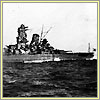

|
|
On her last morning, before the first American planes intercepted her,
Yamato would have appeared indestructible. After all, she was the
heaviest and most powerful battleship ever built, carrying the most formidable
guns ever mounted at sea. This photograph was taken in December 1941, shortly
after the Yamato first took to the sea.
|
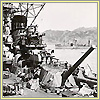

|
|
As she came under attack on that April morning, the
Yamato fired her 18-inch guns at approaching American aircraft,
one-third of which were torpedo bombers that hit from low altitudes. This image
of the battleship gives a sense of the 18-inch guns' enormous size (note sailors on deck).
|
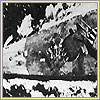

|
|
Cloud cover precluded accurate firing of the
battleship's guns. Almost all of the nearly 400 American fighters and bombers
sent to engage Yamato made it into position above her and soon began to
strafe the battleship with bullets and drop 1,000-pound bombs. Here, an
aircraft's overhead view of its target. This particular image was taken during an earlier battle with American carrier aircraft on October 24, 1944 as Yamato transited the Sibuyan Sea.
|
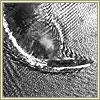

|
|
Torpedoes explode against Yamato's port side
as she turns to avoid the onslaught from bombers.
|


|
|
While the Americans' 1,000-pound bombs held fearsome destructive power, as seen in
this one exploding off Yamato's port bow, it was their air-launched torpedoes
that ultimately led to the supership's demise.
American aviators received orders to drop their
torpedoes such that they would penetrate Yamato below the waterline near
her bow and stern where her armor was thinnest. They were also instructed to
concentrate their torpedoes on just one of Yamato's sides, an approach
most likely to cause flooding and eventual sinking. Note the fire in one of the
ship's aft turrets.
|
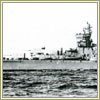

|
|
Eight Japanese destroyers and one cruiser, the Yahagi (left), tried to assist Yamato in fending off her attackers. By the end of the battle, Yahagi and all eight destroyers were lost.
|
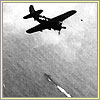

|
|
After a dozen torpedo hits, even the Yamato's
1,000 watertight compartments couldn't save her, and her lower decks rapidly
began to flood. A Curtiss Helldiver bomber like the one seen at right
photographed the destruction. At this point, after just a few hours of battle,
most of the American pilots returned to their carriers, knowing
Yamato's injuries were fatal. In all, Yamato took 12 bomb and
seven torpedo hits within two hours of battle.
|
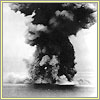

|
|
An astounding series of explosions onboard
Yamato produced the mushroom cloud seen here shortly before she sank. Yamato
settled on the seafloor 1,200 feet down and about 50
miles southwest of Kyushu, Japan. Experts believe that a fire raging in the
battleship's aft secondary magazine caused tons of ammunition to ignite almost simultaneously,
producing the blasts that tore the ship in half and sank her. These
blasts were perhaps the largest ever to occur at sea.
|
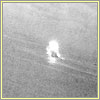

|
|
One of the final photographs of the supership shows her severely damaged hull
burning just prior to disappearing beneath the waves. When Yamato sank, marking the last Japanese
naval action of the war, she took 2,747 men with her—all but 269 of her crew.
Surrounding Japanese ships lost an additional 1,167 men. Only 10 American aircraft
went down in the battle, with the loss of just 12 men.
|

| 
|

